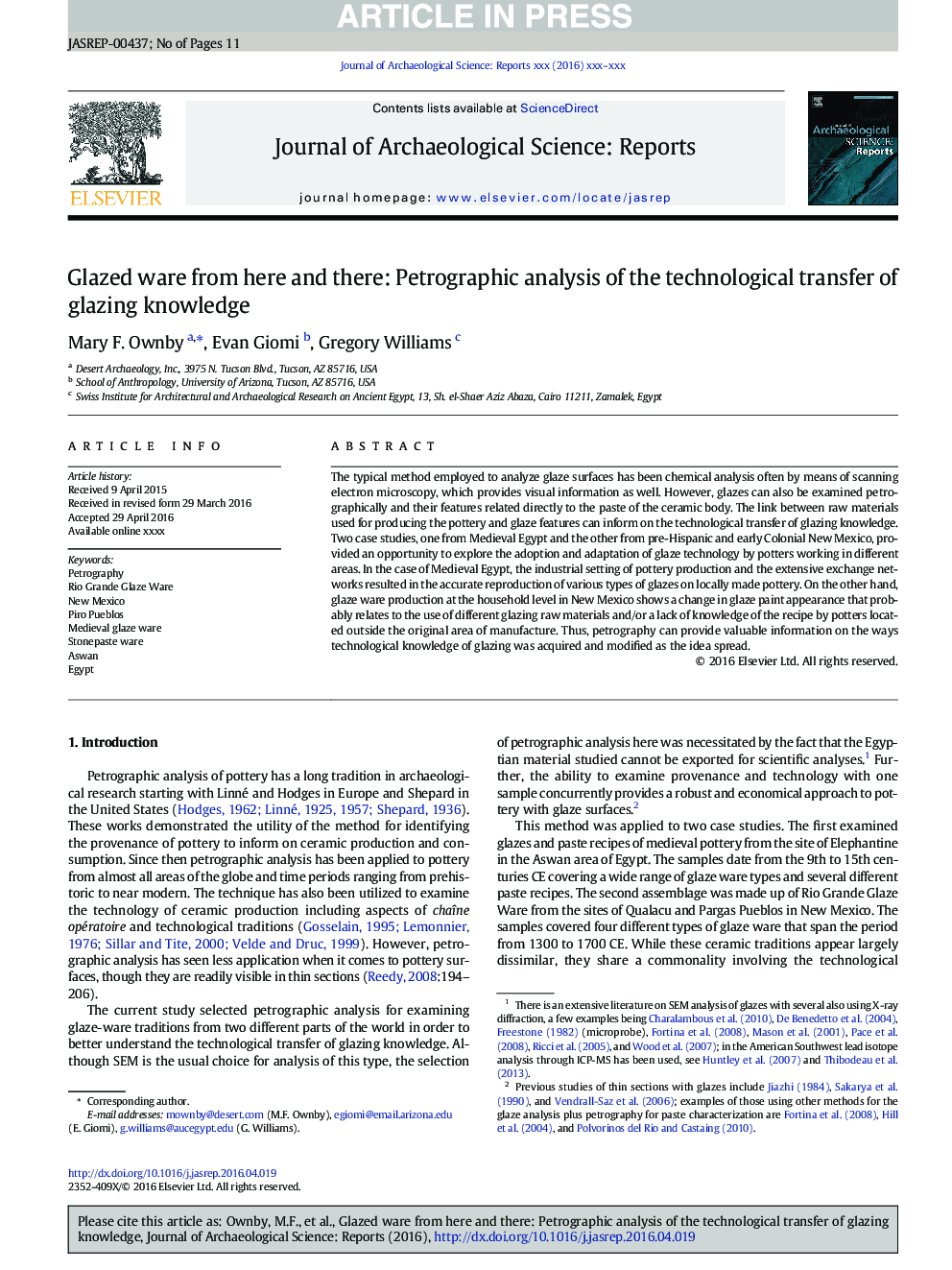| کد مقاله | کد نشریه | سال انتشار | مقاله انگلیسی | نسخه تمام متن |
|---|---|---|---|---|
| 7445036 | 1483927 | 2017 | 11 صفحه PDF | دانلود رایگان |
عنوان انگلیسی مقاله ISI
Glazed ware from here and there: Petrographic analysis of the technological transfer of glazing knowledge
ترجمه فارسی عنوان
کاردستی های شیشه ای از اینجا و آنجا: تجزیه و تحلیل پتروگرافی از انتقال تکنولوژی دانش لعاب
دانلود مقاله + سفارش ترجمه
دانلود مقاله ISI انگلیسی
رایگان برای ایرانیان
ترجمه چکیده
روش معمولی برای تحلیل سطوح لعاب، اغلب با استفاده از میکروسکوپ الکترونی اسکن شده است که اطلاعات بصری را نیز فراهم می کند. با این حال، لعاب ها نیز می توانند به صورت سنگی مورد بررسی قرار گیرند و ویژگی های آنها به طور مستقیم به خمیر بدن سرامیکی مرتبط است. ارتباط بین مواد خام مورد استفاده برای تولید سفال و ویژگی های لعاب می تواند در انتقال تکنولوژی دانش لعاب آگاه باشد. دو مطالعه موردی، یکی از قرون وسطی مصر و دیگری از قبل از اسپانیایی و اولیه استعمارگر نیومکزیکو، فرصتی برای کشف پذیرش و تطبیق تکنولوژی لعاب توسط متفکرانی که در مناطق مختلف کار می کنند، فراهم می کند. در مورد مصر قرون وسطی، محیط صنعتی تولید سفالی و شبکه های تبادل گسترده منجر به تولید دقیق انواع مختلف لعاب ها در سفال های محلی شد. از سوی دیگر، تولید لعاب در سطح خانوار در نیومکزیکو، تغییر در ظاهر رنگ لعابی را نشان می دهد که احتمالا مربوط به استفاده از لایه های مختلف مواد خام و یا عدم شناخت این دستور توسط گلدان ها در خارج از محدوده اصلی است از تولید بنابراین، پتروگرافی می تواند اطلاعات ارزشمندی در مورد چگونگی دست یابی دانش فنآوری لعاب به دست آورد و اصلاح شود.
موضوعات مرتبط
علوم انسانی و اجتماعی
علوم انسانی و هنر
تاریخ
چکیده انگلیسی
The typical method employed to analyze glaze surfaces has been chemical analysis often by means of scanning electron microscopy, which provides visual information as well. However, glazes can also be examined petrographically and their features related directly to the paste of the ceramic body. The link between raw materials used for producing the pottery and glaze features can inform on the technological transfer of glazing knowledge. Two case studies, one from Medieval Egypt and the other from pre-Hispanic and early Colonial New Mexico, provided an opportunity to explore the adoption and adaptation of glaze technology by potters working in different areas. In the case of Medieval Egypt, the industrial setting of pottery production and the extensive exchange networks resulted in the accurate reproduction of various types of glazes on locally made pottery. On the other hand, glaze ware production at the household level in New Mexico shows a change in glaze paint appearance that probably relates to the use of different glazing raw materials and/or a lack of knowledge of the recipe by potters located outside the original area of manufacture. Thus, petrography can provide valuable information on the ways technological knowledge of glazing was acquired and modified as the idea spread.
ناشر
Database: Elsevier - ScienceDirect (ساینس دایرکت)
Journal: Journal of Archaeological Science: Reports - Volume 16, December 2017, Pages 616-626
Journal: Journal of Archaeological Science: Reports - Volume 16, December 2017, Pages 616-626
نویسندگان
Mary F. Ownby, Evan Giomi, Gregory Williams,
